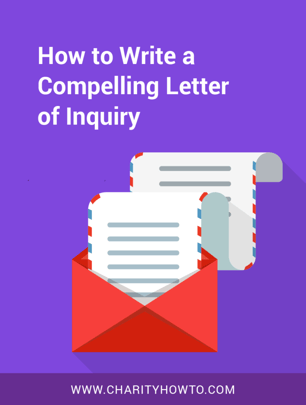Blog post by Diane H. Leonard, GPC
Letter writing may seem like a lost art, but done well, it has the potential to open doors for funding opportunities. Specifically, a well written letter of inquiry can open to the door for you to submit a full proposal to a grantmaker to support your organization.

Many grantmakers have implemented the process of letters of inquiry from potential grant seekers as a way to learn more about your agency, understand your ideas, and determine if it is a good fit with their mission.
Letters of inquiry can serve multiple purposes including saving time for both funders and grant seekers and building relationships. With the increased utilization of online grant applications, we have seen the use of letters of inquiry grow, with the submission of the inquiry often taking place via an online portal like those offered by Foundant or CyberGrants to grantmakers.
Making a First Impression with an LOI
Whether the letter of inquiry (referred frequently to as an LOI) is submitted as a hard copy letter, emailed attachment, or online submission, this is a critical first impression that your organization is making on a grantmaker.
The successful reading of your letter of inquiry is measured by whether or not your letter results in an invitation to submit a full proposal to the grantmaker.
The unsuccessful reading of your letter of inquiry may result in a formal declination or sometimes of silence, with the silence meaning that the grantmaker is not interested in receiving a full proposal.
If your letter of inquiry is not accepted by a grantmaker, ensure that you learn their guidelines for when/if they are willing to accept another letter of inquiry from your organization.
It is at the discretion of the grantmaker to decide what their acceptance policy is for letters of inquiry. They can choose to have you wait 12 months between unsuccessful letters of inquiry. They can also choose to have your one unsuccessful submission be the end of their willingness to review an inquiry from your organization.
As grant professionals/grant writers recognize that the letter of inquiry is a critical step of building relationships and grant revenue, a great deal of attention and emphasis is placed on writing a compelling and competitive letter of inquiry.
Letters of inquiry are deceivingly simply, often less than one page if printed. Your letter of inquiry should be a brief, clear, concise description of your agency’s strengths, knowledge, and abilities that leads the funder to want to request a meeting and/or invite you to submit a full proposal.
5 Key Items to Include in Your Letter of Inquiry
The following describes five key items you should include in your letter of inquiry to ensure you are as competitive in the letter of inquiry (LOI) review process as possible:
1. Make Your Request
Start your letter with a clear statement describing what you are asking for.
i.e. – The xxx organization respectfully requests permission to submit a full proposal to the xxx Foundation for $xx to support the xxx program.
2. State Your Need
Why are you requesting funding? What is the need? Provide clear data and statistics that are relevant to the project. Stick closely with the facts. Connect the dots for how the need you plan to address aligns with the grantmaker’s goals and priorities.

3. Project Description
How do you propose to meet the need described above? Again, this should be brief and specific.
4. Project Outcomes
Using SMART objectives, list what your project will accomplish. What are SMART objectives you ask?
- S = Specific
- M = Measurable
- A = Attainable
- R = Realistic
- T = Time-bound
5. LOI Closing
Reaffirm *briefly* how your project fits with the funder’s mission. Explain that you look forward to providing more detailed information in a meeting or full proposal and provide your organization leader’s contact for both phone and email questions or follow-up.
Simple, right? As it is often a one-page document, or a short character counted response, it is a deceivingly simple document. Don’t sell the letter of inquiry short. This is a critical first step in the grant seeking process for many foundations.
Looking for more support in crafting a compelling letter of inquiry? Join me for my CharityHowTo webinar, Mastering Critical 1st Step for Grants: Letter of Inquiry (LOI).
About the Author
Diane H. Leonard, GPC, President of DH Leonard Consulting & Grant Writing Services, is an experienced and respected grant professional who has provided grant development counsel to nonprofit organizations of varying size and scope for more than a decade. In addition, Diane is an in-demand speaker and trainer on the topics of grant readiness, grant writing and grants management and regularly provides her expertise to audiences ranging from national conferences to boards of directors for small, nonprofit organizations.
